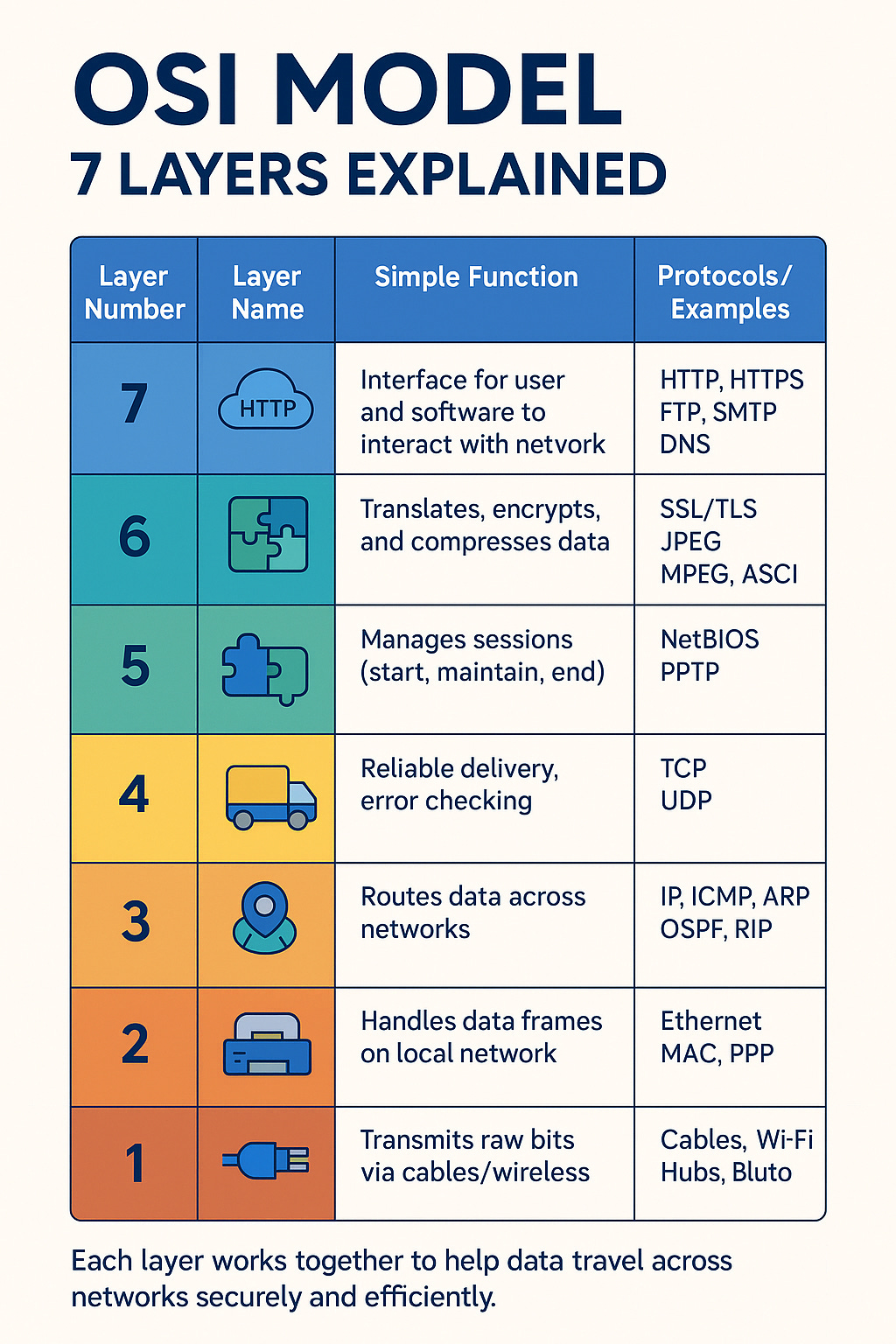🧠 OSI Model – The 7-Layer Framework Every Tech Professional Should Know
If you work in tech — as a developer, tester, DevOps engineer, network admin, or even product manager — you’ve likely run into weird bugs, timeouts, or security hiccups that left you wondering: Where exactly is this breaking?
Enter the OSI Model — your go-to mental map for understanding how data moves from your laptop to a remote server (and back), across networks, protocols, layers, and devices.
🚀 What Is the OSI Model?
The OSI (Open Systems Interconnection) Model breaks network communication into 7 layers, each with a clear role. Together, they make sure data gets from Point A to Point B — securely, reliably, and efficiently.
Imagine sending a parcel:
You write the message 📝 (Application Layer)
Translate & seal it 📦 (Presentation)
Start the delivery session 🚚 (Session)
Split it into boxes 📦📦 (Transport)
Add addresses 🏷️ (Network)
Use the local courier 🏢 (Data Link)
Deliver it physically 📮 (Physical)
That’s how your data travels online.
🧩 OSI Model – 7 Layers Explained
Layer 7 – Application
This is where users interact with network-based apps like browsers, email, or WhatsApp.
👉 Example protocols: HTTP, HTTPS, FTP, SMTP, DNS
Layer 6 – Presentation
This layer prepares data for the application by formatting, encrypting, or compressing it.
👉 Example: SSL/TLS (for encryption), JPEG, ASCII
Layer 5 – Session
Manages conversations (sessions) between devices — starting, maintaining, and ending them.
👉 Example: NetBIOS, PPTP
Layer 4 – Transport
Breaks data into packets, ensures it reaches the right app, handles retries and flow control.
👉 Example: TCP (reliable), UDP (fast but no guarantee)
Layer 3 – Network
Decides the best route to send data from source to destination across networks.
👉 Example: IP, ICMP, ARP, OSPF
Layer 2 – Data Link
Transfers data between devices in the same network and adds MAC addresses.
👉 Example: Ethernet, MAC address, PPP
Layer 1 – Physical
Moves raw bits (0s and 1s) through cables, Wi-Fi signals, or fiber optics.
👉 Example: Cables, Wi-Fi, Bluetooth, Hubs
👩💻 Why This Matters for
Every Role in Tech
✅ Developers
Understand how your front-end talks to back-end APIs and what can go wrong in that journey.
✅ QA Engineers
Diagnose test failures caused by session timeouts, protocol mismatches, or network delays.
✅ DevOps / SREs
Pinpoint issues in distributed systems: Is it DNS? Firewall? App port? OSI helps break it down fast.
✅ Security Engineers
Design protections across layers: encryption (Layer 6), firewalls (Layer 4), access controls (Layer 2), and more.
✅ Product Managers / Leads
Communicate more effectively with your tech teams by understanding how systems actually connect.
📷 A One-Page Visual to Simplify It All
To make learning easier, I’ve created a color-coded, beginner-friendly diagram that shows all 7 layers, their role, and real-world protocol examples.
✋ Final Takeaway
Understanding the OSI Model isn’t just theory — it’s a practical skill that helps you debug smarter, design better systems, build secure networks, and communicate clearly across teams in today’s connected tech world.
Whether you’re shipping code, testing features, maintaining uptime, or explaining bugs to stakeholders — this 7-layer model gives you clarity and confidence in how data truly flows.
👉 Like this kind of breakdown?
Subscribe for beginner-friendly guides on Cloud, DevOps, Networking, and Tech Fundamentals — explained clearly, without jargon.
Let’s make tech simple, together. 🚀





